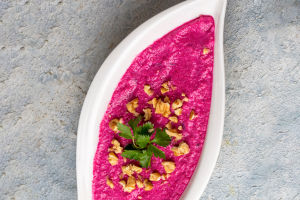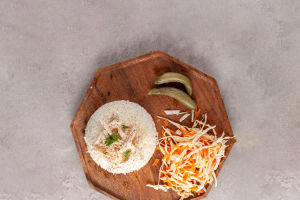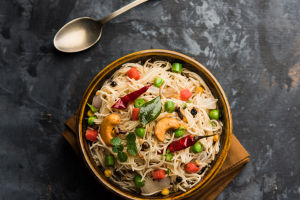Experience the two-fold pleasure of Moti Pak, a glorious treat that combines the elegance of Motichoor pearls with a creamy Mawa center.
This traditional dessert is a masterpiece that effortlessly draws you into its delectable symphony of textures and flavors. A must-have for any celebration, especially during Diwali, Moti Pak is sure to impress your family and friends.
What is Moti Pak?
The term ‘Moti Pak’ derives from two Hindi words: ‘Moti,’ meaning pearls or boondi, and ‘Pak,’ meaning a dish or delicacy.
This iconic sweet features a delightful contrast of textures: the outer layers are made from motichoor (boondi), while the middle layer is a rich, smooth mawa dough. The three-layer combination of besan (gram flour), mawa, milk powder, sugar, and ghee creates a decadent dessert subtly flavored with cardamom powder and saffron.
The result is a heavenly blend of aromatic boondi and mawa that promises an indulgent experience in every bite.
Why You’ll Love Moti Pak
Moti Pak brings joy and satisfaction with every piece. Here’s why you’ll fall in love with this dessert:
Flavorful Layers: Soft, decadent layers that melt in your mouth.
Fudge-like Consistency: Dense and creamy, perfect for indulging your taste buds.
Beautiful Appearance: Its visually striking layers make it even more irresistible.
Perfectly Balanced: Ideal proportions of sweetness and texture.
Scalable Recipe: Easy to adjust for any occasion or guest list.
Make Ahead: Prepare this treat in advance to save time during celebrations.
Dear Lykkers! Made with common pantry staples, Moti Pak is a fun and rewarding recipe to try, especially during festivals and spiritual occasions. Additionally, it makes a wonderful gift option for friends and family!
Ingredients for Moti Pak
Ricotta Cheese: Unsalted ricotta cheese or crumbled mawa forms the base for the mawa layer.
Ghee: Use unsalted butter or homemade ghee for its rich flavor in the mawa mixture.
Milk Powder: Full-fat milk powder enhances the creaminess of the mawa layer.
Powdered Sugar: The sweetener that adds the perfect balance to the mawa.
Cardamom Powder: Ground cardamom brings an irresistible aroma and subtle flavor to the mix.
Besan (Chickpea Flour): The main ingredient for making the motichoor pearls.
Orange Food Color: Adds a vibrant touch to the pearls, making them even more tempting.
Ghee for Frying: For a nutty flavor when frying the motichoor pearls, ghee is ideal, though any neutral oil can also be used.
Sugar: Sweetens the motichoor pearls.
Rose Water: Adds a delicate floral aroma to the dish.
Lemon Juice: Prevents the sugar syrup from crystallizing.
Slivered Pistachios and Melons: Used for garnishing to add a festive touch.
Moti Pak Recipe Tips and Variations
Perfecting the Motichoor Pearls:
The batter for motichoor pearls should be smooth and free of lumps. Fine besan ensures a perfect texture. Sieve the besan before adding water to avoid any lumps.
Frying Temperature:
Maintaining the right temperature when frying is crucial. Too high a heat makes the boondi crispy and prevents it from soaking up the syrup, while too low a heat makes the boondi greasy. Low to medium heat is ideal for perfectly cooked motichoor pearls.
Ghee for Extra Flavor:
While oil can be used for frying, ghee provides a rich, nutty flavor that makes the motichoor even more delicious.
Avoid Over-frying:
Over-fried boondi can become crispy and will not absorb the sugar syrup. Ensure to fry the pearls just enough to absorb the syrup and remain soft.
The Right Sugar Syrup Consistency:
Achieving the correct consistency is essential for making perfect motichoor. A one-string consistency is ideal for soaking the pearls, while anything thicker or thinner may lead to imperfect results.
Shaping and Cutting Moti Pak
Pulse Large Boondi Pearls:
For an even layer, pulse the large boondi pearls in a blender for a few seconds to break them into smaller, more delicate pieces.
Soaking Boondi:
To help the boondi soak up the syrup, add it to the lukewarm sugar syrup immediately after frying. If allowed to cool, the boondi won’t absorb the syrup properly.
Fixing Runny Batter:
If the batter is too runny, add a tablespoon of milk powder to improve its consistency. This ensures that the pearls hold their shape when fried.
Cooking the Mawa Mixture:
Use a heavy-bottomed pan to cook the mawa mixture, as thin pans tend to burn the ingredients. Cook the mixture over medium-low heat, stirring constantly, to avoid scorching and to achieve a smooth texture.
Ghee for Binding:
For better binding, add a teaspoon of ghee to the mixture. Ghee helps shape the dessert better than oil due to its thick consistency.
Final Touches and Serving
Once the Moti Pak layers are set, let them cool completely before cutting into squares. Use a clean tool for each cut to maintain the integrity of the pieces. Garnish with slivered pistachios and melon seeds to add a touch of elegance and extra flavor.
This Moti Pak recipe delivers a magical experience at any celebration. With its rich, indulgent layers and aromatic flavor, it’s sure to impress everyone who tries it. Whether you’re hosting a festival or gifting it to friends, this traditional Indian treat is bound to be a hit!
Ready to indulge in the magic of Moti Pak? Let’s begin this delicious journey!


